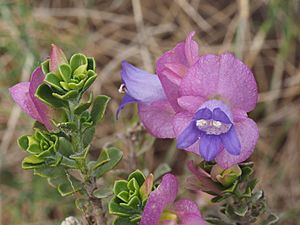Pinyuru facts for kids
Quick facts for kids Pinyuru |
|
|---|---|
 |
|
| Eremophila cuneifolia - form with colourful sepals | |
| Scientific classification | |
| Genus: |
Eremophila (plant)
|
| Species: |
cuneifolia
|
The Eremophila cuneifolia, also known as pinyuru, is a type of flowering plant. It belongs to the figwort family, called Scrophulariaceae. This plant is special because it is endemic to the north-west part of Western Australia. This means it grows naturally only in that area. Pinyuru is a spreading, sticky shrub with unique wedge-shaped leaves. It has colorful parts called sepals and usually deep purple flowers.
Contents
What Pinyuru Looks Like
Pinyuru is a shrub that spreads out and can grow to be about 0.4 to 1.8 meters (1 to 6 feet) tall. Its branches and leaves are covered with tiny hairs and a thick, shiny, sticky substance called resin. The leaves grow in a special way: they are arranged one after another and are grouped together near the ends of the stems.
Most leaves are about 5 to 16 millimeters (0.2 to 0.6 inches) long and 3 to 14 millimeters (0.1 to 0.6 inches) wide. They are shaped like a wedge or a heart, and each one has a small, distinct point at its tip. The leaves are thick and stiff. The top surface of the leaves is smooth and hairless (this is called glabrous), while the bottom surface has hairs.
The flowers grow one by one where the leaves meet the stem. They are on hairy stalks that are 1 to 3.5 millimeters (0.04 to 0.14 inches) long. Each flower has five parts called sepals. These sepals are cream-colored to light reddish-purple and overlap slightly. They are egg-shaped and vary in size, but most are 8.5 to 26 millimeters (0.3 to 1.0 inches) long.
The petals are 16 to 26 millimeters (0.6 to 1.0 inches) long and are joined together at the bottom to form a tube. This petal tube is usually deep purple on the outside, but sometimes it can be lighter. Inside, it is white with purple spots. There are some hairs on the outside of the tube and on the petal tips, but the tube itself is full of long, soft hairs. The four stamens (the parts that produce pollen) are completely hidden inside the tube.
Pinyuru usually flowers from June to October. After the flowers, the plant produces fruits. These fruits are oval or cone-shaped, shiny, and 5.5 to 9 millimeters (0.2 to 0.4 inches) long.
How Pinyuru Got Its Name
The scientific name for this plant, Eremophila cuneifolia, was first officially described by a scientist named Friedrich Wilhelm Ludwig Kraenzlin in 1929. He published his description in a scientific book.
The first plant sample (called the type specimen) was collected by an explorer named Charles Crossland. He found it near Mount Hale, close to the Murchison River. This area is about 140 kilometers (87 miles) west-north-west of Meekatharra.
The second part of the plant's scientific name, cuneifolia, tells us something about its leaves. It comes from two Latin words: cuneus, which means "wedge," and folium, which means "a leaf." So, cuneifolia means "wedge-leaved," describing the shape of its leaves.
Where Pinyuru Grows
Pinyuru grows in several areas of Western Australia. You can find it between the towns of Leonora, Jigalong, and Onslow. It lives in different types of natural areas, which scientists call biogeographic regions. These include the Carnarvon, Little Sandy Desert, Central Ranges, Murchison, Pilbara, and Gascoyne regions.
This plant can grow in many different kinds of soil and habitats. It often grows alongside other types of Eremophila plants. Sometimes, pinyuru is even the most common plant species in an area.
Pinyuru's Conservation Status
The Government of Western Australia's Department of Parks and Wildlife has looked at the status of Eremophila cuneifolia. They have classified it as "not threatened." This means that the plant is not currently in danger of disappearing.
Growing Pinyuru in Gardens
Pinyuru is considered one of the most beautiful Eremophila plants to grow in gardens. People like its colorful sepals and deep purple flowers. However, it can be a bit tricky to grow and keep healthy, especially in places with high humidity, like Sydney.
To grow pinyuru, it is often started by a method called grafting. This is where a part of the pinyuru plant is joined onto another plant, usually a Myoporum, so it can grow better. It also needs soil that drains water well. Pinyuru does not like cold weather or frost, so it might be best to grow it in a pot. This way, you can move it to a warmer spot when the seasons change.
Images for kids
-
Habit near Ophthalmia Dam, Newman
-
Habit near the Kennedy Range




